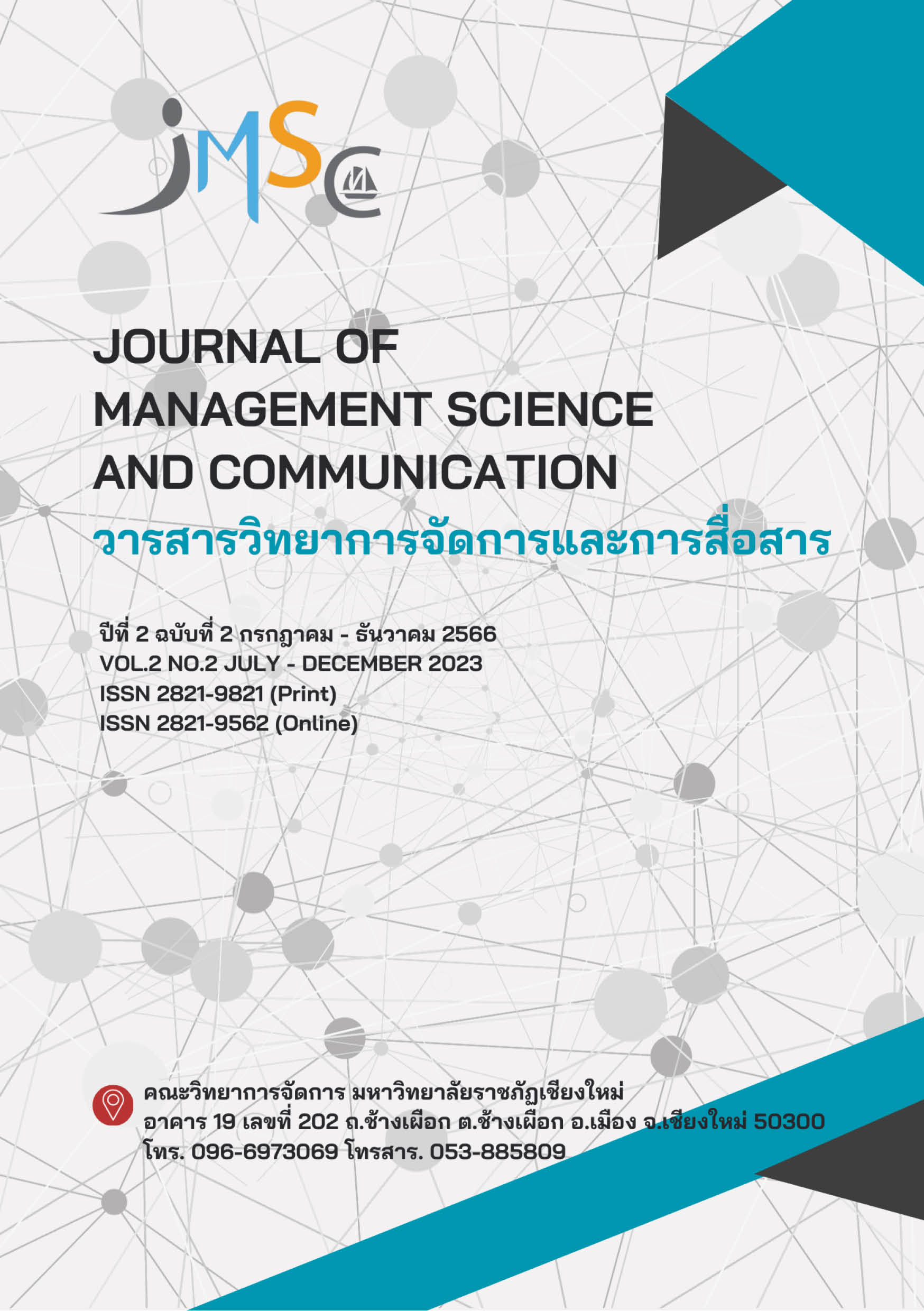Upgrading local herbs to support agricultural tourism A case study of San Sai Mahawong Subdistrict, Saraphi District, Chiang Mai Province
Main Article Content
Abstract
This research to upgrade local herbs to support agricultural tourism: A case study of San Sai Mahawong Subdistrict, Saraphi District, Chiang Mai Province. Using Participatory Action Research with the desire to develop a career and create a new career. Developing existing community products to support new careers and adding new products derived from local wisdom to meet standards, safety, and acceptance and build confidence for consumers. The researcher conducted a field trip to study various contexts to study the current environment and the expected future environment of the community. Therefore, the tools to analyze the current environment and potential were held meetings with the people and related agencies. In this regard, training on marketing and product development has been organized by developing an existing product of 1 type, which is Chiang Da vegetable tea and proceeding to create a new product of 1 type, namely Herbal hand soap. Because most of the people in San Sai Mahawong sub-district are farmers and prefer to cultivate many medicinal plants. It shows that the herbs in these communities will be able to generate income and provide an alternative career path for the people in the sub-district. This research can enable the locality to have a learning center or community learning center. To transfer knowledge in product development and organize agrotourism by drawing on the strengths of the area that focuses on integrated farming as a point that can create value for products and services in the community This enables communities to be self-reliant in a sustainable manner and lead to a strong community and encouraging people in the community to reduce their expenditures by growing seasonal vegetables for their households.
Downloads
Article Details

This work is licensed under a Creative Commons Attribution-NonCommercial-NoDerivatives 4.0 International License.
References
กรมประชาสัมพันธ์ สำนักนายกรัฐมนตรี. (2565). เศรษฐกิจ BCG โมเดลพัฒนาชาติ. https://www.prd.go.th/th/content/category/detail/id/39/iid/13808
จตุรงค์ เลาหะเพ็ญแสง. (2560). การพัฒนาผลิตภัณฑ์ตามแนวคิดเศรษฐกิจสร้างสรรค์จากทุนวัฒนธรรมเมืองนครชุม จังหวัดกำแพงเพชร. วารสารครุศาสตร์อุตสาหกรรม. 16(2). 63-71.
จำเนียร จวงตระกูล. (2561). ปัญหาการกำหนดกลุ่มตัวอย่างและวิธีการสุ่มตัวอย่างในการวิจัยเชิงคุณภาพ. วารสารบริหารธุรกิจและสังคมศาสตร์ มหาวิทยาลัยรามคำแหง, 1(2), 1-21.
นุชนารถ สมควร, รักชนก ชำนาญมาก และวณิชชา ณรงค์ชัย. (2564). เศรษฐศาสตร์การเมือง กับการเปลี่ยนแปลงค่านิยมอุดมการณ์สู่การกลายเป็นเกษตรกรผู้ประกอบการ . วารสารศิลปศาสตร์ มหาวิทยาลัยธรรมศาสตร์, 21(2), 216–247. https://doi.org/10.14456/lartstu.2021.25
ประไพพิมพ์ สุธีวสินนนท์ และ ประสพชัย พสุนนท์. (2559). กลยุทธ์การเลือกตัวอย่างสำหรับการวิจัยเชิงคุณภาพ. วารสารปาริชาติ มหาวิทยาลัยทักษิณ. 29(2). 32-48.
เปรมปรีดา ทองลา และนันทภัค บุรขจรกุล. (2565). การพัฒนาศักยภาพการท่องเที่ยวเชิงเกษตรชุมชนปัถวี จังหวัดจันทบุรี. วารสารวิชาการบัณฑิตวิทยาลัยสวนดุสิต, 18(2), 175-190.
รัชฎาพร เกตานนท์ แนวแห่งธรรม. (2560). แนวทางการพัฒนาผลิตภัณฑ์ภูมิปัญหาท้องถิ่นเพื่อส่งเสริมเศรษฐกิจสร้างสรรค์ในจังหวัดนครปฐม. Veridian E-Journal ฉบับภาษาไทย มหาวิทยาลัยศิลปกร. 10 (1). 994-1013.
สุรชัย กังวล. (2558). การศึกษาความเข้มแข็งและการวิเคราะห์เหตุปัจจัยที่มีอิทธิพลต่อการเกิดหนี้ที่ไม่ก่อให้เกิดรายได้ของสถาบันการเงินชุมชมในเขตภาคเหนือ. วารสารสมาคมวิจัย. 20(1). 74-84.
สำนักงานคณะกรรมการพัฒนาเศรษฐกิจและสังคมแห่งชาติ. (2559). ทิศทางของแผนพัฒนาเศรษฐกิจและสังคมแห่งชาติ ฉบับที่ 12. http://www.sukhothai.go.th/.pdf
สำนักงานสภาพัฒนาเศรษฐกิจและสังคมแห่งชาติ. (2561). โครงการการพัฒนาระบบสถิติทางด้านข้อมูลและตัวชี้วัดเพื่อใช้เป็นส่วนหนึ่งในการบริหารงานราชการแผ่นดินตามยุทธศาสตร์ชาติ. http://nscr.nesdc.go.th/uploads/2021.pdf
สำนักงานพัฒนาเศรษฐกิจและสังคมภาคเหนือ. (2563). แนวทางการพัฒนาพื้นที่ระเบียงเศรษฐกิจพิเศษภาคเหนือ. (Northern Economic Corridor: NEC – Creative LANNA). https://shorturl.asia/jDJXy
สำนักงานพัฒนาเศรษฐกิจและสังคมภาคเหนือ. (2564). แนวทางการพัฒนาพื้นที่ระเบียงเศรษฐกิจพิเศษ ภาคเหนือ. สำนักงานสภาพัฒนาการเศรษฐกิจและสังคมแห่งชาติ.
สำนักงานพัฒนาวิทยาศาสตร์และเทคโนโลยีแห่งชาติ (2566). โมเดลเศรษฐกิจใหม่ BCG. https://www.nstda.or.th/home/knowledge_post/bcg-by-nstda/
สำนักงานส่งเสริมเศรษฐกิจสร้างสรรค์ (องค์การมหาชน). (2566). พระราชกฤษฎีการจัดตั้งสำนักงานส่งเสริมเศรษฐกิจสร้างสรรค์ (องค์การมหาชน) พ.ศ.2561. https://www.cea.or.th/storage/app/media/ITA2564/Royal-Decree-for-CEA-Establishment.pdf
อภิศักดิ์ ธีระวิสิษฐ์. (2565). เทคนิคและเครื่องมือสื่อความคิดในการศึกษาชุมชน. http://www.tsdf.nida.ac.th › article-file-11244
อัจฉรา ชีวะตระกูลกิจ. (2553). การออกแบบระบบการจัดทำต้นทุนผลผลิตของมหาวิทยาลัยสุโขทัยธรรมาธิราช. วารสารการจัดการสมัยใหม่, 8 (1), 1-16.
เอื้อมพร หลินเจริญ. (2555). เทคนิคการวิเคราะห์ข้อมูลเชิงคุณภาพ. วารสารคณะศึกษาศาสตร์ มหาวิทยาลัยมหาสารคาม. 17(1). 17-29.
Carter, N. (2014). The Use of Triangulation in Qualitative Research. Oncology Nursing Forum, 41(5), 545-547.
Cohen, J.M. & Uphooff, N.T. (1981). Rural Development Participation: Concept and Measures for Project Design Implementation and Evolution Rural Development Committee Center for International Studies. New York : Longman.
Cooper, R. G. (2011). Winning at New Products; Creating Value Through Innovation, 4th ed. Press : Basic Books.
Ghazinoory, S., Abdi, M., & Azadegan-Mehr, M. (2011). SWOT Methodology: A State-of-the-Art Review for the Past, A Framework for the Future. Journal of Business Economics and Management, 12(1), 24-48.
Gutierrez, P. H., & Dalsted, N. L. (1990). Break-even Method of Investment Analysis. https://extension.colostate.edu/docs/pubs/farmmgt/03759.pdf
MacLennan, N. (2017). Coaching and Mentoring. London: Routledge.
Phadermrod, B., Crowder, R. M., & Wills, G. B. (2019). Importance-Performance Analysis Based SWOT Analysis. International Journal of Information Management, 44, 194-203.
Sanoff, H. (1999). Community Participation Methods in Design and Planning. New York: John Wiley & Sons.
Sullivan, R. (2000). Entrepreneurial Learning and Mentoring. International Journal of Entrepreneurial Behavior & Research, 6(3), 160-175.


